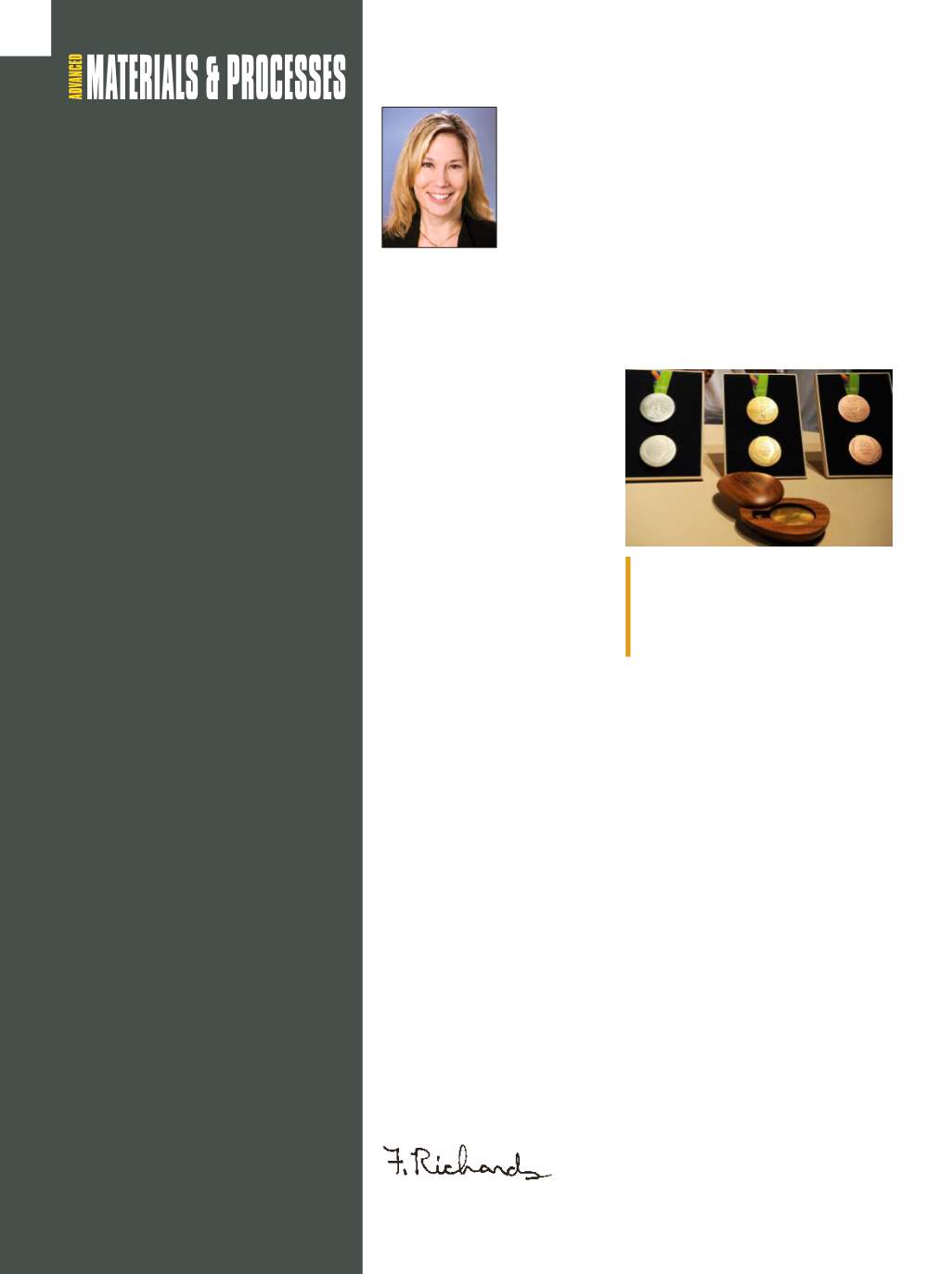

4
A D V A N C E D M A T E R I A L S & P R O C E S S E S | S E P T E M B E R 2 0 1 6
ASM International
9639 Kinsman Road, Materials Park, OH 44073
Tel: 440.338.5151 • Fax: 440.338.4634
Frances Richards,
Editor-in-Chief
frances.richards@asminternational.orgJulie Lucko,
Editor
julie.lucko@asminternational.orgEd Kubel and Erika Steinberg,
Contributing Editors
Jim Pallotta,
Creative Director
jim.pallotta@asminternational.orgKate Fornadel,
Layout and Design
Kelly Sukol,
Production Manager
kelly.sukol@asminternational.orgPress Release Editor
magazines@asminternational.orgEDITORIAL COMMITTEE
Jaimie Tiley,
Chair,
U.S. Air Force Research Lab
Somuri Prasad,
Vice Chair,
Sandia National Lab
Yu-Ping Yang,
Past Chair,
EWI
Ellen Cerreta,
Board Liaison,
Los Alamos
National Lab
Steven Claves,
Alcoa Technical Center
Mario Epler,
Carpenter Technology Corp.
Adam Farrow,
Los Alamos National Lab
Nia Harrison,
Ford Motor Co.
Yaakov Idell,
NIST
John Shingledecker,
EPRI
Kumar Sridharan,
University of Wisconsin
ASMBOARDOF TRUSTEES
Jon D. Tirpak,
President
William E. Frazier,
Vice President
Sunniva R. Collins,
Immediate Past President
Craig D. Clauser,
Treasurer
Ellen K. Cerreta
Kathryn Dannemann
Ryan M. Deacon
Jacqueline M. Earle
John R. Keough
Zi-Kui Liu
Sudipta Seal
Tirumalai S. Sudarshan
David B. Williams
Tom Dudley,
Interim Managing Director
STUDENT BOARDMEMBERS
Swetha Barkam, Allison Fraser, Rachael Stewart
Individual readers of Advanced Materials & Processes may,
without charge, make single copies of pages therefrom for per-
sonal or archival use, or may freely make such copies in such
numbers as are deemed useful for educational or research
purposes and are not for sale or resale. Permission is granted
to cite or quote fromarticles herein, provided customary
acknowledgment of the authors and source is made.
The acceptance and publication of manuscripts in Advanced
Materials & Processes does not imply that the reviewers,
editors, or publisher accept, approve, or endorse the data,
opinions, and conclusions of the authors.
T
he Rio 2016 Olympic Games were just as inspiring as
ever, watching the human form do things that seem
completely impossible and against all laws of phys-
ics and gravity. Mastering the sheer willpower, courage,
and years of training it takes to compete at the highest lev-
els of sport is beyond the grasp of most of us, and is what
makes viewing these events so enjoyable. But what about
the medals themselves? Now here’s something that metal-
lurgists and materials scientists of all disciplines will likely appreciate more than
other people.
Interestingly, the last Olympic “gold” medal actually made of pure gold was
awarded in 1912. Now, the National Olympic Committee (NOC) permits signif-
icant freedom to the host city with
regard to the exact medal compo-
sition and design, although certain
rules must be followed. Gold med-
als must be awarded for first place,
measure at least 60 mm in diameter
and 3 mm thick, contain a minimum
of 92.5% silver, and be covered
with at least six grams of pure gold.
Further, although the host city is
allowed to design the medals, the
NOC has the final say on approval.
Each host city also must mint its
own medals.
In Rio, the medals theme
focused on sustainability with this
year being the first time the awards were made with more than 30% recycled
precious metal for both silver and bronze. The silver was recycled from mirrors
and x-ray sheets, while the copper used in the bronze medals was salvaged and
repurposed from the local mint’s old, discarded machinery. In addition, the gold
used in the medals is free of mercury in order to prevent pollution and to be
more health-conscious for the miners. Finally, the medal cases are made of cer-
tified recycled wood that comes from a sustainable environmental management
area in Brazil.
In other news regarding materials innovations, the U.S. Department of
Energy announced in mid-August that it will invest $16 million to accelerate
design of new materials by using supercomputers. Two four-year projects, one
led by DOE’s Oak Ridge National Laboratory and the other by Lawrence Berke-
ley National Laboratory, intend to use the superfast computers at DOE’s labs by
“developing software todesign fundamentally new functional materials destined
to revolutionize applications in alternative and renewable energy, electronics,
and a wide range of other fields.” Teams include experts from universities as well
as other national labs.
According to the DOE, researchers are expected to develop sophisticated
open-source software to capture the physics of relevant systems, which can then
be used by the broader research community and industry to accelerate design of
new functional materials. Who knows? Results may prove important enough to
win a Nobel Prize, a medal still made of pure gold.
frances.richards@asminternational.orgGOING FOR THE GOLD
2016 Olympic medals are made of mercury-
free gold and recycled silver and bronze,
and come with sustainable, recycled wood-
en cases. Courtesy of Tomaz Silva/Brazil
Agency.


















